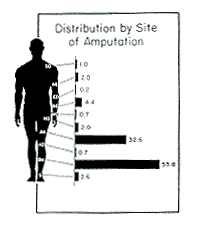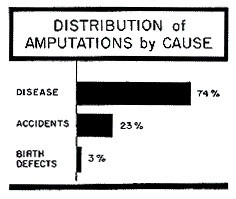 There are slightly more than 1.5 amputees per 1000 persons in the United States and Canada. Therefore, the present total in the United States is approximately 380,000.
There are slightly more than 1.5 amputees per 1000 persons in the United States and Canada. Therefore, the present total in the United States is approximately 380,000.
 Amputations are caused by:
Amputations are caused by:
The accidents most likely to result in amputation are traffic accidents, followed by farm and industrial accidents.
Amputations in the case of disease are performed as a lifesaving measure. The diseases that cause the most amputations are peripheral vascular disease (poor circulation of the blood) and cancer.
Congenital disorders or defective limbs present at birth are not amputations, but rather are a lack of part or all of a limb. A person with a limb deficiency can usually be helped by use of an artificial limb. Sometimes amputation of part of a deformed limb or some other type of surgery may be desirable before the application of an artificial limb.
The distribution of amputations by cause is shown below:
 There are slightly more than 1.5 amputees per 1000 persons in the United States and Canada. Therefore, the present total in the United States is approximately 380,000.
There are slightly more than 1.5 amputees per 1000 persons in the United States and Canada. Therefore, the present total in the United States is approximately 380,000.
There are more "below-knee" (trans-tibial) amputees than any other type as can be seen from the chart below.
Surgeons preserve the knee joint whenever it is practical to do so and will fashion the stump at the lowest practical level. Very short stumps make fitting extremely difficult and very long below-knee stumps are prone to circulation problems.
The Syme's amputation, which is essentially removal of the foot at the ankle, usually results in a stump that will bear a substantial part of the body weight over the end.
The electronic version of this manual is presented by Dankmeyer, Inc., with the permission of the authors. This manual may not be redistributed in any form.